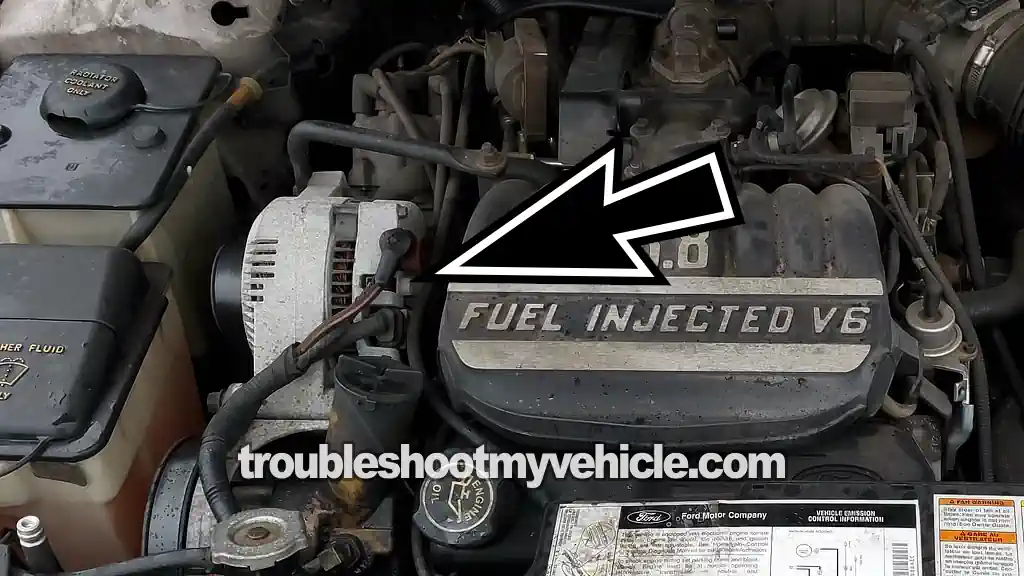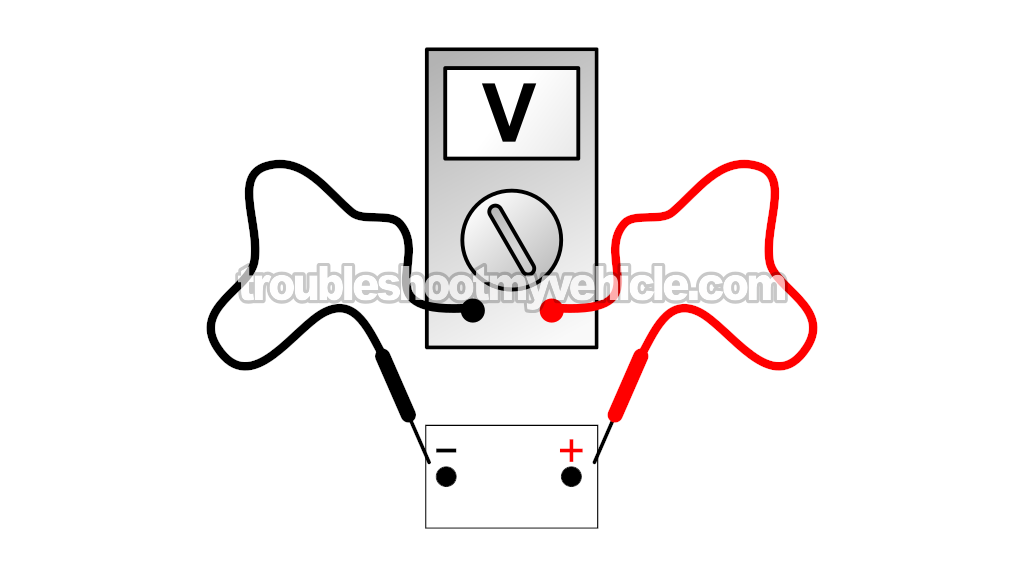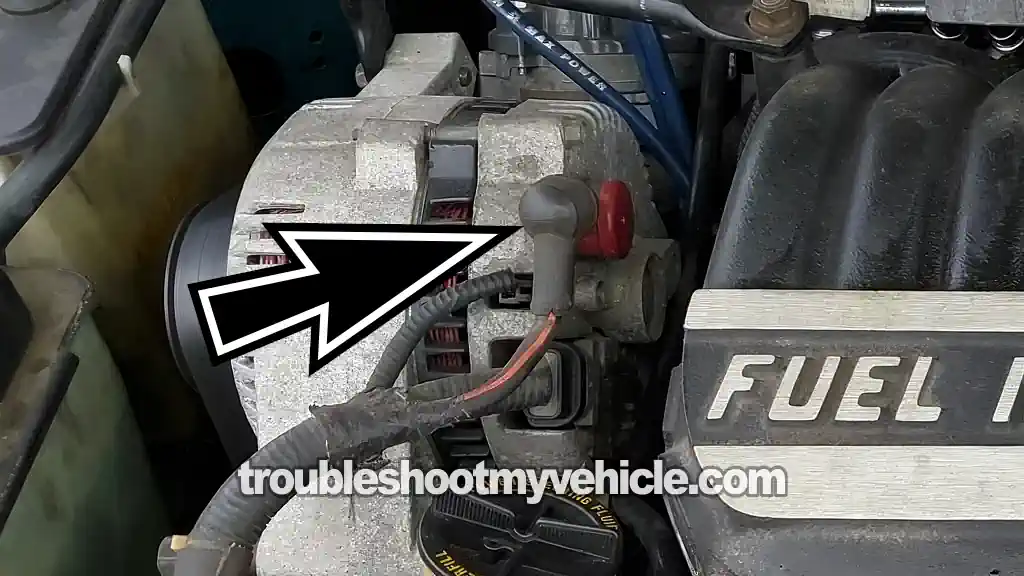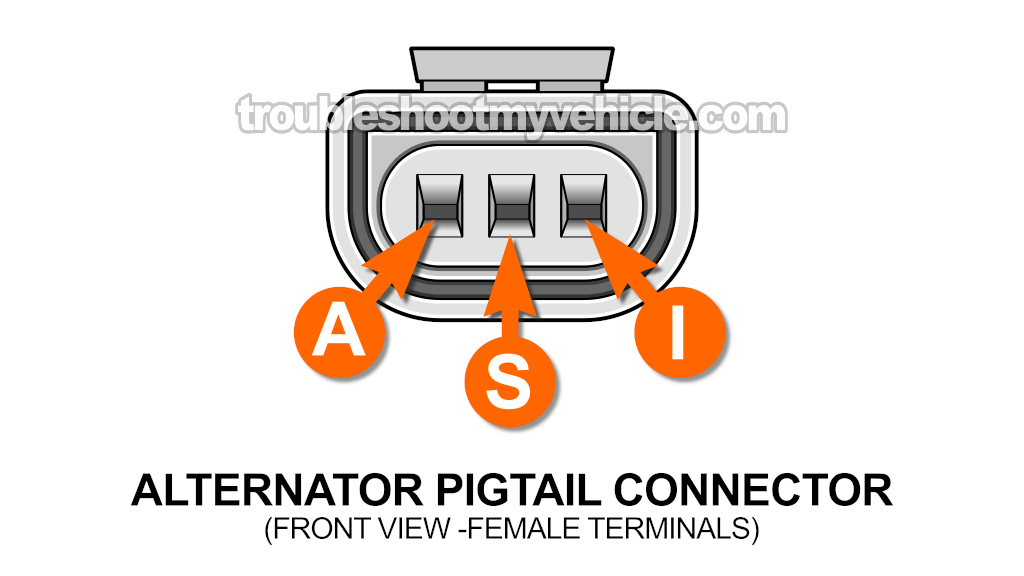
The alternator on your 1990-1995 3.8L V6 Ford Taurus or Mercury Sable is a whole lot easier to test than you think. You don't need any fancy diagnostic equipment —just a multimeter.
In this tutorial, I'm going to show you how to test it to see if it's charging the battery or if it's kicked the bucket and needs to be replaced.
All the steps are explained in a simple, step-by-step way so you can quickly figure out if the "no-charge" issue is due to a bad alternator.
Contents of this tutorial:
APPLIES TO: This tutorial applies to the following vehicles:
- 3.8L V6 Ford Taurus: 1990, 1991, 1992, 1993, 1994, 1995.
- 3.8L V6 Mercury Sable: 1990, 1991, 1992, 1993, 1994, 1995.
3.0L V6 TAURUS/SABLE - 3.8L V6 WINDSTAR: The alternator test for these vehicles can be found here:
- How To Test The Alternator (1994-1995 3.0L V6 Ford Taurus, Mercury Sable).
- How To Test The Alternator (1996-1998 3.8L V6 Ford Windstar).
- How To Test The Alternator (1999-2003 3.8L V6 Ford Windstar).
Symptoms Of A Bad Alternator
As you already know, the alternator's job on your Ford Taurus or Mercury Sable is to keep the battery charged so that it's ready to crank and start the engine the next time you need it.
When the alternator fails, the first thing you'll notice is the charge light glowing nice and bright on the instrument panel. Along with that, you'll usually experience one or more of the following symptoms:
- Engine won't crank: The engine doesn't turn over. The only way to get it started is by jump-starting it with another vehicle.
- Battery fully discharged: The engine only cranks and starts after you've recharged the battery.
- Dim headlights: The front headlights shine with less than normal brightness when turned on.
TEST 1: Checking Battery Voltage With The Engine Running

Before we get started, it's important to make sure that the battery is fully charged. The reason for this is that we'll need to start the engine and let it run for about 5 to 10 minutes during the test.
If you haven't done so yet, go ahead and charge the battery completely. Once that's done, you're ready to begin testing the alternator.
As I mentioned earlier, the only tool you'll need is a multimeter. If you don't have one or need to upgrade, this is the same one I personally use and recommend —it's reliable, accurate, and affordable: Tekpower TP8268 AC/DC Auto/Manual Range Digital Multimeter (Amazon affiliate link).
Alright, here we go:
- 1
Start the engine and let it idle.
NOTE: Be careful, since you'll be working around a running engine. - 2
Place your multimeter in Volts DC mode.
- 3
Connect the red multimeter test lead to the battery positive (+) terminal.
- 4
Connect the black multimeter test lead to the battery negative (-) terminal.
- 5
Your multimeter should register 13.5 to 14.5 Volts DC.
If if doesn't, don't worry. Continue to the next step. - 6
Have an assistant turn ON everything and anything that uses electricity inside the vehicle like: headlights, windshield wipers, turn signals, a/c or heater blower on high, etc.
This will put an electrical load on the alternator to either confirm it's really working or it's fried. - 7
Your multimeter will register one of two things:
1.) The multimeter will register a nice and steady 13.5 to 14.5 Volts DC no matter what gets turned on.
2.) It will register 12.5 Volts DC and this voltage will decrease more and more as you turn on stuff inside your vehicle.
Let's see what your test result is telling us:
CASE 1: Your multimeter registered 13.5 to 14.5 Volts. This test result confirms that your Taurus or Sable's alternator is working correctly and charging the battery as it should.
If you're still finding a dead battery every time you try to start the engine, then the alternator isn't the culprit —it's doing its job. In this case, the most likely cause of the problem is:
- A bad battery that's no longer holding a charge and needs to be replaced.
- A parasitic load that's draining the battery when the engine is OFF.
CASE 2: Your multimeter registered a voltage that steadily dropped to 9 Volts. This test result tells you that the alternator is not charging the battery.
In about 90% of cases, this confirms that the alternator is bad and needs to be replaced to fix the no-charge condition.
However, to be absolutely sure before replacing it, we'll run two additional quick and easy tests. For the first of these, head over to: TEST 2: Testing The Continuity Of The Battery Circuit.
TEST 2: Testing The Continuity Of The Battery Circuit

The alternator's charging output reaches the battery through one main wire —the large wire connected with a nut to the single stud located on the back of the alternator (the arrow in the photo above points to this BATT+ stud).
This BATT+ circuit is protected by an inline fusible link. If it's blown, the alternator could be working perfectly fine, but its charging output will never reach the battery —resulting in a constantly discharged battery.
In this test, you'll verify that the inline fusible link (or fuse) is intact by doing a simple continuity test with your multimeter set to Ohms mode.
Let's get going:
- 1
Disconnect the battery negative (-) cable from the battery.
NOTE: This is important, do not proceed beyond this point without first disconnecting the battery negative (-) cable. The battery positive cable must remain connected to the battery. - 2
Set your multimeter to Ohms mode.
- 3
Place the red multimeter test lead on the center of the stud to which the large wire is attached to with a nut.
The arrow in the photo above points to this BATT+ stud. - 4
With the black multimeter test lead, probe the center of the battery positive (+) post on the battery.
- 5
You'll see one of two results on your multimeter:
1.) No Continuity —If the inline fusible link (or fuse) protecting this circuit is blown, your multimeter will indicate a reading of OL (which means over limit).
2.) Continuity —If the inline fusible link (or fuse) is OK and not blown, your multimeter will register an Ohms reading of 0.5 Ohms or less.
OK, now that the testing part is done, let's take a look at what your results mean:
CASE 1: Continuity is present. This is good, since it indicates that the inline fusible link or fuse is OK and not blown.
The last test to do, is to verify that the alternator's voltage regulator is getting 12 Volts. These 12 Volts are provided through a regular plastic blade type fuse. OK, for this test go to: TEST 3: Making Sure The Voltage Regulator Is Getting 12 Volts.
CASE 2: Continuity IS NOT present. This test result tells you that the BATT+ cable delivering the alternator's charge to the battery is open. Even if the alternator itself is working correctly, its charging output will never reach the battery.
Your next step is to locate the fusible link that protects this BATT+ cable. Depending on your vehicle's year, this fusible link will be located either at the starter relay (1990-1991) or at the under-hood fuse/relay box (1992-1995).
Once you've found it, inspect the inline fusible link to see if it's blown. If it is, replace it with a fusible link of the same rating.
Once this circuit has continuity, the no-charge condition should be resolved. However, to confirm the repair, you'll still need to repeat all of the alternator tests once the replacement is complete.
TEST 3: Making Sure The Voltage Regulator Is Getting 12 Volts

The voltage regulator on your Ford Taurus or Mercury Sable's alternator is mounted right on the back of the alternator assembly.
This component —the voltage regulator— needs a steady 12 Volts to begin energizing the alternator so it can start producing a charge for the battery.
These 12 Volts are supplied through the yellow with white stripe (YEL/WHT) wire, which connects to female terminal A of the voltage regulator's 3-wire connector (see the connector pinout illustration above).
This circuit is protected by an inline fusible link. Depending on the specific year of your Taurus or Sable, this fusible link will either be located at the starter relay or inside the under-hood fuse/relay box.
The voltage on this YEL/WHT wire is available at all times —it does not depend on the key being in the ON or START position.
To check for the presence of this voltage at terminal A, we'll perform a simple multimeter voltage test.
Let's get started.
- 1
Reconnect the negative (-) battery cable to the battery's negative (-) post,.
- 2
Disconnect the 3-wire pigtail connector from the alternator.
This 3-wire connector connects to the alternator's voltage regulator. - 3
Set your multimeter to Volts DC mode.
- 4
Connect the black multimeter test lead to the battery negative (-) terminal.
IMPORTANT: The multimeter test lead must connect to a clean spot on the battery's negative (-) terminal. - 5
Connect the red multimeter test lead to the female terminal labeled with the letter A of the alternator's 3-wire pigtail connector (see the illustration above).
NOTE: Make sure that the terminal you're probing actually connects to the YEL/WHT wire. - 6
Your multimeter should register 10 to 12 Volts DC.
NOTE: Power is present at all times, no need to turn the key to the ON position.
Let's interpret your test result:
CASE 1: 10 to 12 Volts Are Present at terminal A. This confirms that the voltage regulator is getting the power it needs to energize the alternator.
You can now conclude that the alternator is bad and needs to be replaced if you've confirmed all of the following:
- TEST 1: Battery voltage decreases when you turn on electrical accessories (headlights, blower motor, turn signals, etc.).
- TEST 2: The BATT+ circuit has continuity.
- This test: The voltage regulator is receiving power at terminal A.
CASE 2: Battery voltage is not present at terminal A. This means the voltage regulator isn't receiving the power it needs to activate the alternator and begin charging the battery.
With this test result, you can rule out the alternator itself as the cause of the no-charge condition in your Ford Taurus or Mercury Sable.
Your next step is to locate the inline fusible link that connects this circuit to battery power. Inspect it and replace it if it's blown, using a fusible link of the same rating. Once power is restored to this circuit, the alternator will start charging the battery again.
NOTE: Depending on your vehicle's year, the location of this inline fusible link will differ:
- 1990-1991 models: The fusible link is located at the starter relay.
- 1992-1995 models: The fusible link is located at the under-hood fuse/relay box.
More 3.8L V6 Ford Taurus Diagnostic Tutorials
I've written quite a few diagnostic tutorials for the 3.8L V6 Ford Taurus and Mercury Sable, including detailed wiring diagrams —and you can find them all in this index:
Here's a sample of the tutorials you'll find in the 3.8L V6 Ford Taurus and Mercury Sable index:
- How To Test The TPS With A Multimeter (1990-1995 3.8L V6 Taurus, Mercury Sable).
- How To Test The MAF Sensor (1991-1995 3.8L V6 Ford Taurus, Mercury Sable).
- How To Test For A Blown Head Gasket (1990-1995 3.8L V6 Ford Taurus, Mercury Sable).
- How To Test The Engine Compression (1990-1995 3.8L V6 Ford Taurus, Mercury Sable).

If this info saved the day, buy me a beer!

